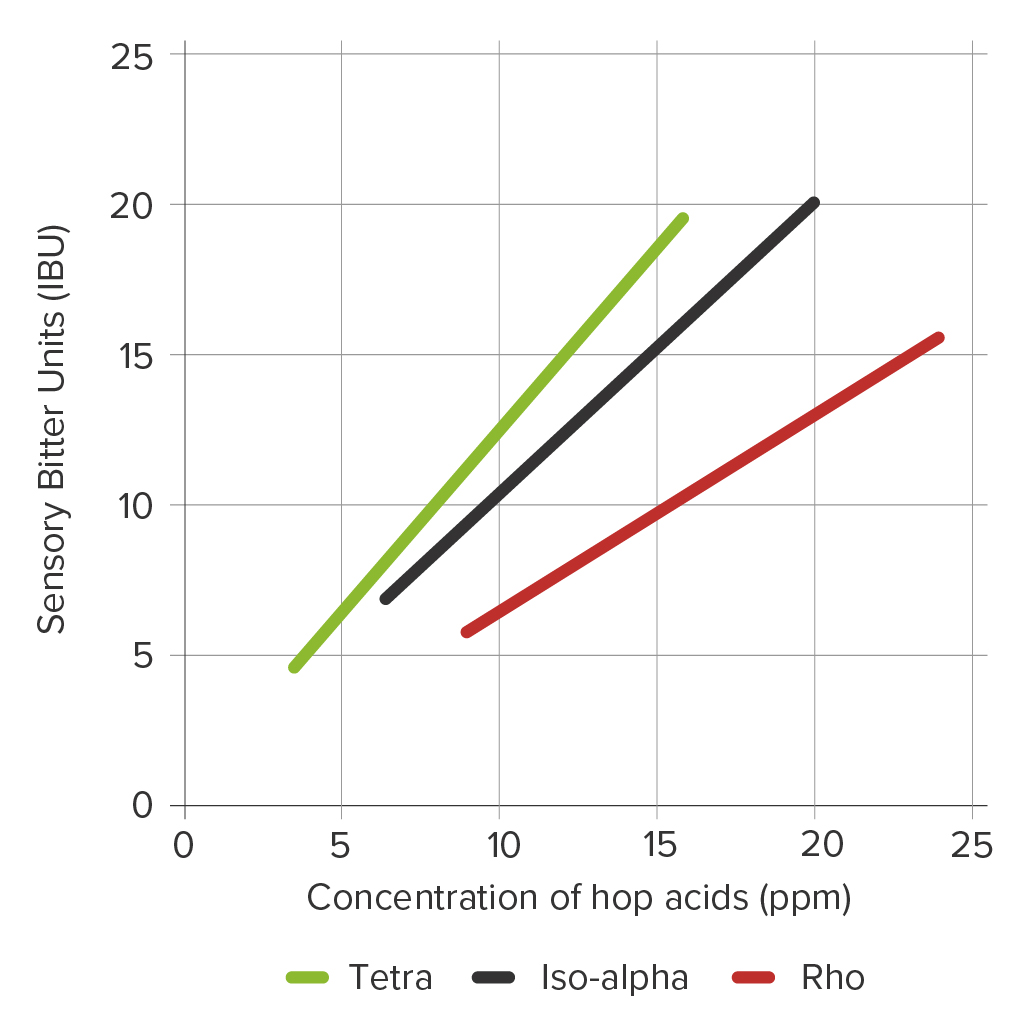
Rho Iso-Extract 30 %
Overview
Rho Iso-Extract 30 % (Rho 30 %) is a pure, aqueous solution of the potassium salts of rho iso-alpha acids derived from CO2 hop extract.
Rho 30 % provides protection against lightstruck flavor when used as the sole source for bitterness or in combination with other light stable hop products.
Compared to the regular iso-alpha acids, Rho 30 % imparts a smoother, non-lingering bitterness.

Specifications
- Short description
- light-stable, aqueous hop extract with mild bitterness
- Alpha acids
- below detection limit
- Iso-alpha acids
- below detection limit
- Rho iso-alpha acids
- 30.0 ± 2.0 % (w/w) HPLC or corresponding UV spectrophotometric value
- pH
- 8.5 ± 0.5
- Density
- ca. 1.08 g / ml (20°C)
- Viscosity
- 20 - 25 mPas (20° C / 68° F)
Properties
Appearance
Rho 30 % is a liquid that is reddish-brown to amber in color. A reversible precipitation may occur under normal storage conditions.
Flavor
Rho 30 % only imparts bitterness. Compared to regular iso-alpha acid products, Rho 30 % lends a smoother, non-lingering bitterness to beer. Depending on the total bitterness and type of beer, the intensity of the bitterness of rho iso-alpha acids is 60 to 70 % of that achieved with iso-alpha acids. Thus, the sensory factor of rho iso-alpha acids is 0.6 - 0.7 times the bitterness of iso-alpha acids at a value of 1.0.
Utilization
When added to conditioned beer prior to the final step in filtration, utilization of rho iso-alpha acids is typically 70 - 85 %. If added to the wort kettle, utilization is around 45 - 55%. Actual utilization will vary from brewery to brewery due to differences in equipment and process conditions.
Light Stability
Rho 30 % only provides protection against lightstruck flavor in the complete absence of alpha acids and iso-alpha acids.
Rho 30 % can be used in conjunction with any Hopsteiner® light stable product to achieve light stability.
Quality
All Hopsteiner® products are processed in facilities which fulfill internationally recognized quality standards.
Packaging
Our products are delivered in their respective recommended standard packaging. Alternatives may be possible upon customer request.
Standard packages of our processing plants in the USA (US) and Germany (DE) are:
- Canister 20 kg (US / DE)
- Jug 10 kg (US)
- Pail 20 kg (US)
Usage
Rho 30 % is typically used as a post-fermentation addition. However, it may be applied as a partial or even complete addition to the wort in order to reduce the risk of bacterial infection.
For Light Stable Beer
For maximum protection against lightstruck flavor, it is essential that no other sources of non-reduced iso-alpha acids are inadvertently introduced into the wort or beer. Therefore, the following must be carefully implemented:
- exclusive use of light stable hop products throughout the entire process.
- avoid contamination through equipment surfaces previously in contact with regular iso-alpha acids.
- never pitch wort with yeast that has been in contact with regular alpha and iso-alpha acids.
Dosage
Dosage of Rho 30 % is based on an estimated or known utilization and the desired intensity of bitterness in the beer. The fact that the bitterness of rho iso-alpha acids is about 30 % less than that of iso-alpha acids derived from conventional hop products must be taken into consideration (see Flavor section).
Application
Dosage during wort boiling can be done without any pre-treatment of the product. For a post-fermentation addition, Rho 30 % should first be heated to 60 ºC (120 ºF) and agitated to ensure dissolution of any precipitated material before use. We recommend in-line additions directly into the beer stream, preferably at a point where vigorous mixing is assured, after primary filtration and gravity adjustment. The addition must be completed prior to final clarification and should take place over at least 70 % of the total volume being transferred. If dilution is necessary, always add Rho 30 % to demineralized water first and adjust the pH to 8.5 - 9.5 using either potassium hydroxide (KOH) or potassium carbonate (K2CO3). Laboratory scale testing is recommended prior to commercial use. If containers are used over several days, it is recommended that the headspace be flushed with nitrogen (CO2 is not suitable).
Cleaning Recommendation
Rho 30 % should not be left in dosing lines at low temperatures. Lines and dosing pumps should be flushed with warm, slightly alkaline, demineralized water or ethanol for purposes of cleaning.
Storage
The recommended storage temperature in the original unopened packaging is 5 - 25 °C (41 - 77 °F).
For prolonged storage, a temperature of 10 - 20 °C (50 - 68 °F) is ideal.
Best Before Date
Under the recommended storage conditions, the shelf life from the date of production/ packaging is at least 3 years.
Safety
Ensure good ventilation of the workplace and wear personal protective equipment. Avoid contact with eyes and skin. Do not inhale vapors or dusts. For full safety information, please refer to the relevant Hopsteiner® safety data sheet.
Analytical Methods
International approved methods listed in commitees such as ASBC or Analytica-EBC using current standards are applied.
Product analytics
- Analytica-EBC 7.9 (HPLC)
Beer analytics
- Analytica-EBC 9.47 (HPLC)
The standard formula for calculating bitter units in beer (Analytica-EBC 9.8 or ASBC Beer-23A) may need to be adjusted as it results in too low values when using higher amounts of Rho 30 %.
Technical Support
We are pleased to offer assistance and advice on:
- safety data sheets
- support for brewing trials on a pilot or commercial scale
- analytical services and information about analytical procedures
Disclaimer: The information provided in this document is believed to be correct and valid. However, Hopsteiner® does not guarantee that the information provided here is complete or accurate and thus assumes no liability for any consequences resulting from its application.
Last updated: 01/07/2024
Save PDF